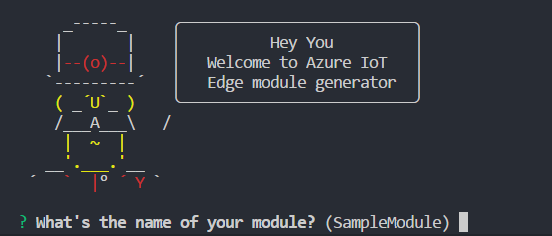generator-azure-iot-edge-module creates a base template to start a new Azure IoT Edge Node.js module
$ npm i -g yo generator-azure-iot-edge-module
$ yo azure-iot-edge-module
If you prefer one-liner:
$ yo azure-iot-edge-module -n <module_name> -r <image_repository>
For example:
$ yo azure-iot-edge-module -n filterModule -r localhost:5000/filtermodule
- Tutorial: Develop and deploy a Node.js IoT Edge module to your simulated device
- Develop and debug Node.js modules with Azure IoT Edge for Visual Studio Code
- Azure IoT Edge
This project welcomes contributions and suggestions. Most contributions require you to agree to a Contributor License Agreement (CLA) declaring that you have the right to, and actually do, grant us the rights to use your contribution. For details, visit https://cla.microsoft.com.
When you submit a pull request, a CLA-bot will automatically determine whether you need to provide a CLA and decorate the PR appropriately (e.g., label, comment). Simply follow the instructions provided by the bot. You will only need to do this once across all repos using our CLA.
This project has adopted the Microsoft Open Source Code of Conduct. For more information see the Code of Conduct FAQ or contact [email protected] with any additional questions or comments.
The team monitors the issue section on regular basis and will try to assist with troubleshooting or questions related IoT Edge tools on a best effort basis.
A few tips before opening an issue. Try to generalize the problem as much as possible. Examples include
- Removing 3rd party components
- Reproduce the issue with provided deployment manifest used
- Specify whether issue is reproducible on physical device or simulated device or both
Also, Consider consulting on the docker docs channel for general docker questions.

